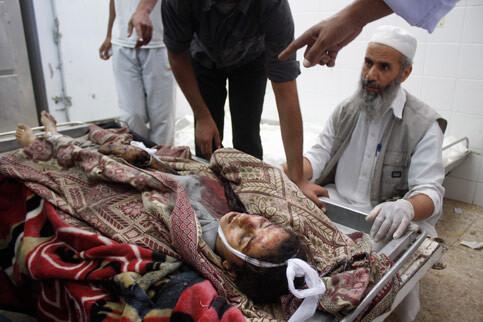Gaza Strip 5 July 2009

Relatives of 17-year-old Hiyam Abu Ayish view her body in the morgue at Gaza’s al-Aqsa hospital a day after she was killed in an Israeli attack, 3 July 2009. (Hatem Omar/MaanImages)
Thursday was as normal and quiet an afternoon as you get in Johr al-Deek village in the central Gaza Strip. “Prepare yourself for I will be taking you to the dentist in half an hour,” Salim Abu Ayish recalled telling his 17-year-old daughter Hiyam.
Moments later everything changed. “At 5:30 PM an Israeli shell landed on my brother’s house,” the father told visitors who had come to offer condolences for his daughter at the family’s home on Friday. The shell injured a nephew and Salim Abu Ayish rushed to render aid.
“I asked Hiyam to bring me the car key from my bedroom,” Salim Abu Ayish said. As she went, he recalled, “suddenly another shell struck my room, killing Hiyam instantly, as shrapnel rippled through her body. I was injured with some of the shrapnel in my back and my neck.”
Two Israeli army shells landed in the family houses of the Abu Ayish clan in the Johr al-Deek village, just north of the al-Bureij refugee camp and about 1.5 kilometers from the border with Israel. The shelling caused critical injury to Husam Abu Ayish, Hiyam’s 21-year-old cousin and minor wounds to Hiyam’s father and sister, Nawal. For hours after the attack, the Israeli army denied any involvement and claimed the attack was the result of mortar shells fired by Palestinians. But late on Thursday, the Israeli army changed its story, admitting that Palestinian civilians were hit “accidentally” by Israeli army fire directed at Palestinian gunmen in the area, according to Israeli media.
Taking a deep breath, and trying to be strong despite his agony, Abu Ayish remembered his daughter: “She used to be humorous, active, well-mannered and smiling. I never turned down her requests. On Thursday, the day her soul went to heaven, she asked me to bring some watermelon, but her destiny was faster than me. Two months ago, she asked me to bring her a necklace, and I did buy her one,” he recalled.
“Hiyam was more than a sister,” recalled Emad, 24, Hiyam’s brother. “She was different from my other five sisters. Just about an hour before she was martyred, she wondered when I would get married.” Emad remembers her saying, “we want to celebrate your wedding, my brother.” Instead of such happy memories, Emad now has only pictures of his sister’s wounded face, taken with his mobile phone.
“Every time she visited our home, my children would get so cheerful as they enjoyed the laughter and fun she would bring to our house,” recalled Saleh Abu Hajjaj, Hiyam’s brother-in-law.
“She was one of my best students,” said Jamal al-Nabahin, a teacher at Qaysaria Secondary School for Girls where Hiyam had recently completed her 11th year certificate. “She was active and sometimes very funny. Her death is a great loss, and may she rest in peace.”
Mahmoud al-Aydi, the father of Raghda, one of Hiyam’s friends and schoolmates, recalled that the two girls had been chatting on the phone shortly before the shells struck. On hearing what had happened Raghda had “fainted for three hours,” according to Raghda’s father, “she could not believe Hiyam was killed.”
Um Jihad, Hiyam’s mother only uttered a few words, “May God hold accountable those who killed my beloved daughter.”
In December 2008 and January 2009, Israel carried out a massive bombardment and invasion of the Gaza Strip. The 22 days of Israeli attacks claimed the lives of 1,400 Palestinians, the vast majority of whom were unarmed civilians. Before and after the attack, Israel has maintained a strict blockade on the coastal territory grossly hampering the daily lives of its 1.5 million residents.
“We have nowhere to go to,” said Hiyam’s father, “Even if we wanted to move, the siege has prevented us from building as there are no building materials available. The situation is extremely difficult, and yet the world keeps silent about our continuing agony.”
Rami Almeghari is a journalist and university lecturer based in the Gaza Strip.





